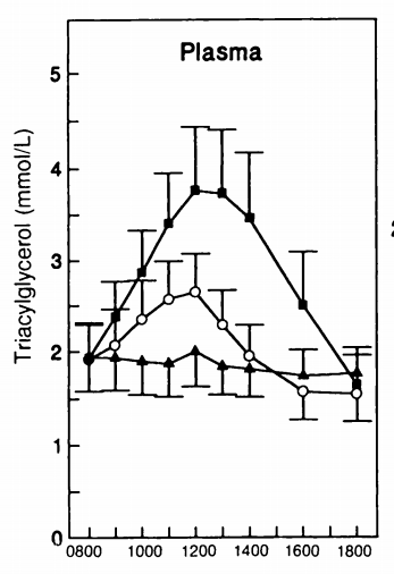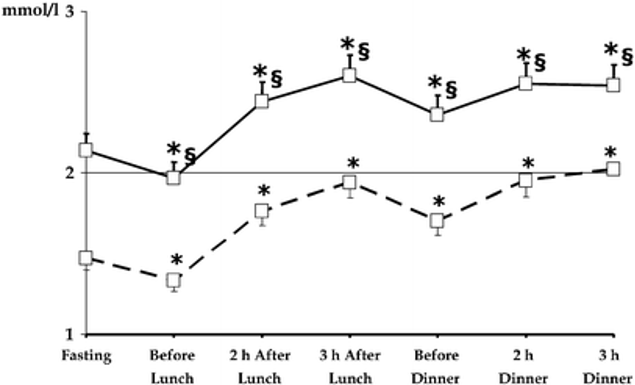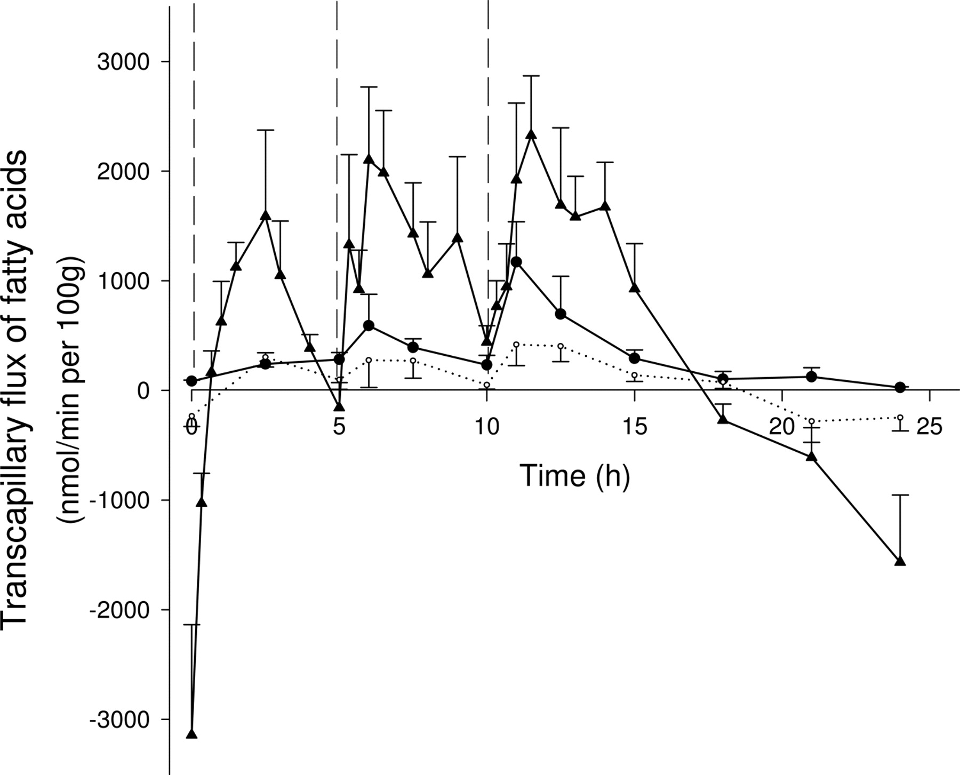Practical Measurements of Postprandial Triglycerides
Lipid Series Part II -- Postprandial Triglycerides
For a kind of recap of healthy and deranged lipid metabolism, let me introduce a review 3 that I have found in the meantime. The author is from the same group at Oxford that produced many of the references used in this series. She, Barbara Fielding, was a colleague of Keith N. Frayn, author of the excellent book I recommended in Part I.
Postprandial lipemia has long been linked to (cardio)metabolic disease 1, and it has been gaining recognition in cardiovascular disease recently, mainly in the form of TG rich remnant lipoproteins 2. I expect that the recognition of the importance of altered lipid metabolism will only increase in the future.
Now that we all share the same understanding, let us see how the principles laid out work in studies that specifically investigated the differences in lipid handling between healthy and insulin resistant (or type 2 diabetic, T2DM) groups. There are two scenarios of interest: the first one is a meal taken after a regular overnight fasting, the second is the usual multi-meal setup, typically three meals a day, that most people tend to follow.
From the Meterbolic Project
Dear Cohort 51 members, dear friends,
Thank you for your interest in this Meterbolic Blogs series. We are pleased to announce the availability of the latest and greatest version of our test-reader app and the first release of the Meterbolic shooting box to make it much simpler to take single and sequential readings.
These address the two most requested enhancements to the service. In addition we now make Lipid profiling available to all new and existing Cohort members, Please reach out ASAP to po@meterbolic.org to receive your add-ons.
Its been hard to stay away from COVID. Accordingly, we will also supply COVID Ag and Serology tests to our new and existing subscribers and will commence a blog series on this topic. Give us a shout if you are interested.
Our very best wishes over the holiday period and let's redouble our efforts in 2021 to overcome not one but now two pandemics.
The history of isotopic tracer, as well as arteriovenous difference tracking studies used in disentangling lipid metabolism is also described in the review [^3]. I would only like to point out two important contexts: 1) The typical curve following a single test meal, almost exclusively done following an overnight fast (again, see [the previous post](https://blogs.meterbolic.org/blog/fasting-and-postprandial-triglycerides) for explanations), and 2) The importance of previous meals in multiple-meal settings.
As for 1), I could not resist to include an old study by Gerald Reaven. Fig. 1. is reproduced from their Figure 1., leaving out lipoprotein subfraction analysis.

Figure 2. Plasma triglyceride response to a high fat meal containing 80 g of fat.
The second point above can be exemplified by a nice study done on 145 type 2 diabetics and 30 healthy controls back in 2004 4, which clearly supports the hypotheses put forward in lipids Post I. Diabetics had not only elevated fasting TG, but also failed to properly clear lipids from their blood after a lunch and dinner sequence of mixed meals. What is more, their TG level increased with every meal, and the second meal was taken well before the first was cleared from the blood, increasing the spike even further after dinner than following lunch. The same phenomenon can be observed in the introductory discussion (Post I, ref. 4 there). The study used a cutoff value of 2 mmol/L, added as a horizontal line in the graph (Figure 2.) below:
 Figure 2. Postprandial triglyceride responses of healthy controls and
type 2 diabetics.
Figure 2. Postprandial triglyceride responses of healthy controls and
type 2 diabetics.
Although the relationship between fasting and postprandial TG seems obvious and a very close one, this is not always the case. To quote the authors
"optimal fasting concentrations are not always a good predictor of postprandial triglycerides." "in 30% of patients with optimal fasting values (<1.69 mmol/l) triglyceride concentrations 3 h after lunch ranged between 1.69 and 2.25 mmol/l, and in 31% they were above 2.25 mmol/l."
This is the main reason why there is extra value in measuring 3-4 hour after a standardized meal.
What is the amount of meal fat required for stressing the system to catch early metabolic derangements? Fortunately, there is a review for that! Mihas and colleagues 3 pulled together data from 113 studies and arrived at the conclusion that 70-79 g fat in a tolerance test is optimal to pinpoint early abnormalities in seemingly healthy participants.
What is the optimal time point to capture? It depends on the amount of fat and carbohydrates in the meal, but to some extent also on metabolic health. In healthy people it is closer to 3 hours, in insulin resistant folks it usually falls just after 4 hours. This way, the 4-hour mark becomes the consensus option, also corroborated by the review above 5 "The main point from this meta-analysis is that the 4 h time-point after an oral fat load during a FTT is the most representative measurement of TGs."
Reaching back to the second factor, namely the role of subsequent meals in influencing lipid levels throughout the day, one truly important conclusion in the review by B. Fielding is that the time spent in "fat-burning mode", more precisely when net lipid outflow from large adipose depots occur, is a very short window that starts 5-7 hours after the last meal, typically when already sleeping, and ends around one hour after breakfast (the first meal of the next day.
"Over the 24 h period, there was net uptake of fatty acids immediately after the first meal, and this continued until approximately 17 h after breakfast, i.e. during the whole of the daytime adipose tissue takes up and stores fatty acids."
Remember this when you design your daily meals from both timing and composition perspectives. You only lose fat when the line marked with triangles drops below the "horizon" in below graph.
 Graph is borrowed directly from 4.
Graph is borrowed directly from 4.
Summary (aka TL;DR)
Although postprandial TG levels are closely linked to fasting values, there are discrepancies that can become important, especially in early stages of metabolic dysfunction. Targeting this impairment is possible via performing a mixed meal tolerance test that contains both high lipids and glucose. TG should be measured at the 4-hour time point (as a minimum requirement). The cutoff point to use is 2.25 mmol/L, although this may be adjusted with accumulation of data that can enable refinements.
(Unit conversion for TG: 1 mmol/L = 88.5 mg/dL, or use a calculator, e.g. this one: https://unitslab.com/node/53)
References
-
Nakamura K, Miyoshi T, Yunoki K, Ito H. Postprandial hyperlipidemia as a potential residual risk factor. Journal of Cardiology [Internet]. 2016 Apr 1 [cited 2020 Dec 23];67(4):335--9. Available from: https://www.journal-of-cardiology.com/article/S0914-5087(15)00383-4/abstract
↩ -
Fujioka Y, Ishikawa Y. Remnant Lipoproteins As Strong Key Particles to Atherogenesis. Journal of Atherosclerosis and Thrombosis. 2009;16(3):145--54. Remnant Lipoproteins As Strong Key Particles to Atherogenesis (jst.go.jp)
↩ -
Jeppesen J, Chen YD, Zhou MY, Wang T, Reaven GM. Effect of variations in oral fat and carbohydrate load on postprandial lipemia. The American Journal of Clinical Nutrition [Internet]. 1995 Dec 1 [cited 2020 Dec 23];62(6):1201--5. Available from: https://doi.org/10.1093/ajcn/62.6.1201>
↩ -
Fielding B. Tracing the fate of dietary fatty acids: metabolic studies of postprandial lipaemia in human subjects. Proceedings of the Nutrition Society [Internet]. 2011 Aug [cited 2020 Oct 22]; 70(3):342--50. Available from: https://www.cambridge.org/core/journals/proceedings-of-the-nutrition-society/article/tracing-the-fate-of-dietary-fatty-acids-metabolic-studies-of-postprandial-lipaemia-in-human-subjects/34A55281E03C01163C6B430B5360F8B6/core-reader
↩ -
Iovine C, Vaccaro O, Gentile A, Romano G, Pisanti F, Riccardi G, et al. Post-prandial triglyceride profile in a population-based sample of Type 2 diabetic patients. Diabetologia [Internet]. 2004 Jan 1 [cited 2020 Aug 2];47(1):19--22. Available from: https://link.springer.com/article/10.1007/s00125-003-1269-3
↩
